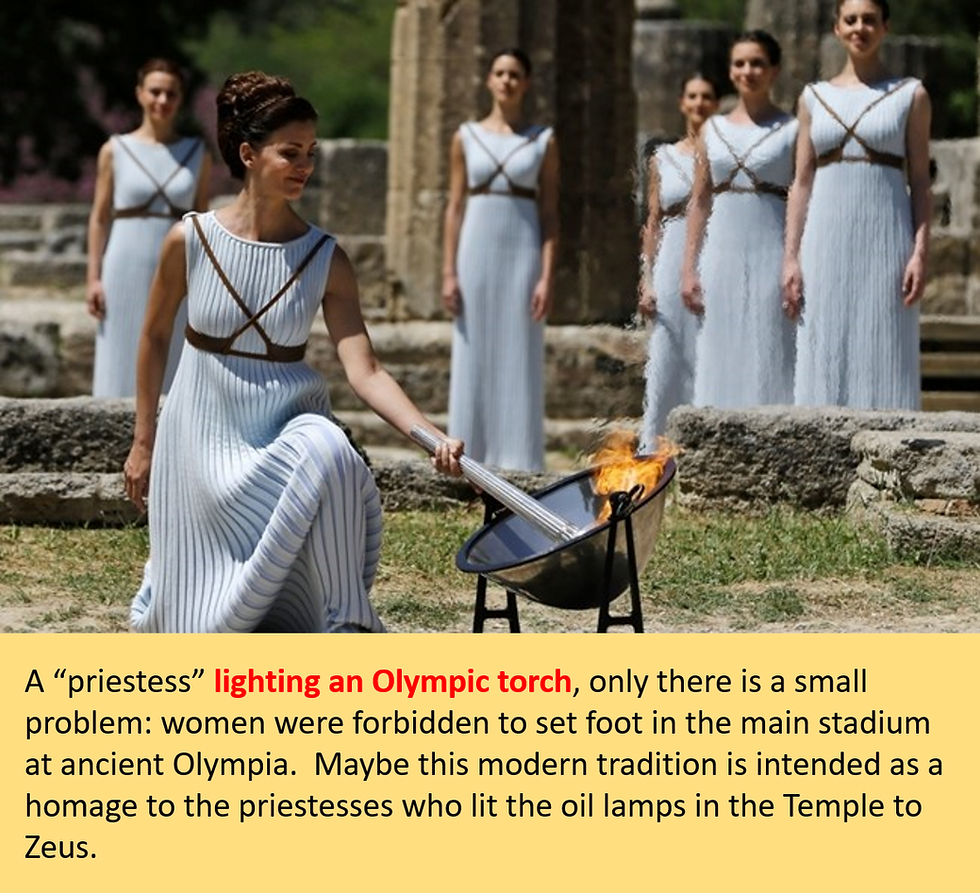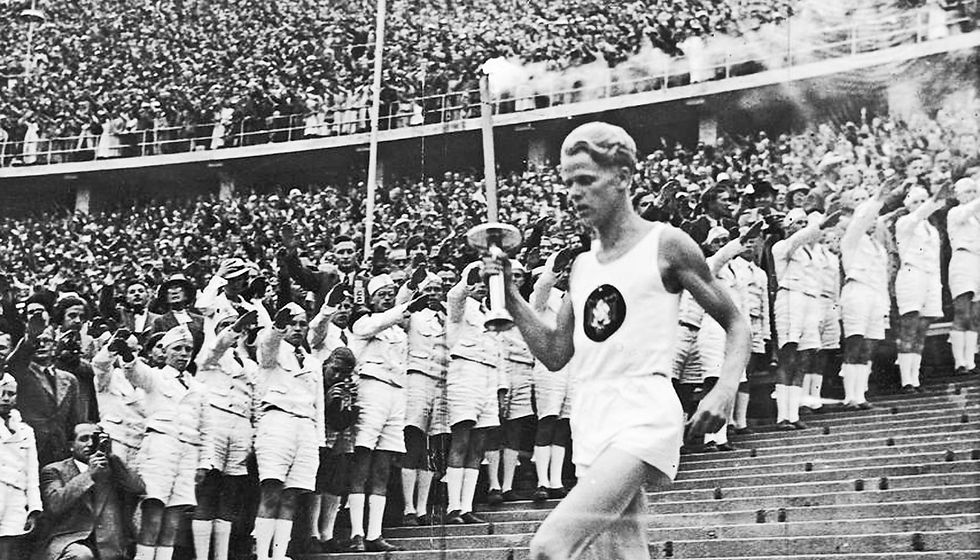Dispelling Some Myths: The Truth Behind the Olympic Torch
- Tastes Of History

- Jul 24, 2020
- 5 min read
Updated: Nov 9, 2025


Let the Games Begin July 24th, 2020 should have seen the opening ceremony of the Games of the XXXII Olympiad of the modern era in Tokyo. The countdown to the Games began with the ceremonial lighting of the Olympic torch on March 12th, 2020. As in previous years, an actress, playing the role of a high priestess, lit the torch from the rays of the sun using a parabolic mirror at the Temple of Hera in ancient Olympia. The torch was then successfully transported from Greece to Japan but shortly thereafter the world was hit by the COVID-19 pandemic. The torch relay was suspended until the following year, beginning again in Naraha, Fukushima on March 25th, 2021. Nearly a year later than originally planned local heroes and celebrities carried and passed on this beacon of inspiration to foster the spirit and excitement of the Games and remind us of all of the long-established traditions perpetuated by the Olympics.
According to the official website, the final course of the relay was altered due to public health concerns about gatherings along the route (for example, the Miyakojima leg was cancelled), and the relay was held without spectators due to states of emergency in some regions (e.g., Matsuyama, Hiroshima, Hyōgo, and Okayama). Eventually the torch relay ended at Tokyo's National Stadium (Olympic Stadium) on July 23rd, 2021 when tennis player Naomi Osaka lit the Olympic cauldron at the finale of the opening ceremony.
A Traditional Opening? In his book “The Invention of Tradition”, Eric Hobsbawm writes that many of our “ancient” customs and ceremonies are often quite recent in origin and sometimes completely made up. Invented traditions can be a great source of amusement because we tend to take them seriously and even get a bit emotional about them with the right kind of brass band and the impetus of a passionate crowd. But as soon as one scratches the historical surface, their true origins come back to bite us on our collective backside. So, does the torch lighting and its subsequent relay really connect us to ancient Olympia, the cradle of the Games? Well, no, not really.
No Symbolic Relevance The Ancient Olympics never had a ceremony (or even an athletic event) involving a torch as a central element. Olympia did have an eternal fire, which was kept burning in honour of Hestia, the goddess of the hearth and this was used to light all the other sacrificial fires throughout the complex of temples.
The Ancient Olympics also had the Hekatomb, a religious ceremony that involved sacrificing 100 oxen and burning their legs on a large pyre in honour of Zeus. However, the torches used to light these fires did not have any particular symbolic relevance. In contrast, the golden sickle used to cut the olive branches for the victors’ wreaths did have a ritual significance as a sacred object.
The Panathenaia festival held in Athens, which lies approximately 265 kilometres east of Olympia, did include a torch event. This was a relay race held alongside other competitive events, rather than a ceremony in and of itself. So, once again the torch had no real connection to ancient Olympia, but it may have been the inspiration for the modern rite.
Music and Poetry So, do the origins of the Olympic torch relay take us back to 1896 and the dawn of the modern Olympics? Short answer, no. French educator and historian, Baron Pierre de Coubertin, who masterminded and co-founded the modern international Olympic movement, had his sights set on convincing the world of the great artistic and educational potential embodied by the newly revived Olympic Games. In his view, the best way to get his point across was to incorporate a flurry of spectacles including art, music, poetry and architecture alongside the athletic competitions. As such there was no torch relay in the 1896 Olympic opening ceremony. Instead, the occasion was marked with a few speeches, an Olympic Hymn performed by nine bands and a 150 strong choir, and a variety of musical offerings.
Nazis The Olympic torch relay as we know it today has a much shadier and a more recent origin. It was invented for the 1936 Berlin Olympics. Many Nazis believed that classical Greece was an Aryan forerunner of the modern German Reich. Hitler, for instance, claimed that the Dorian tribe which had migrated into Greece from the north was of German origin, and Goebbels referred to the Acropolis as the cradle of Germanic culture. Pure fantasy, but Nazi Germany was keen to use the Olympics as a tool to lend credibility to their phoney historical theories.
The 1936 Games, and in particular all the fanfare that surrounded them, had been planned with immense care by the Nazi leadership to project the image of the Third Reich as a modern, rich, and influential state. The torch relay, itself fabricated specifically for the occasion, was part of this carefully orchestrated Nazi propaganda stunt.

It was German classical scholar and sports administrator Carl Diem who came up with the theatrics of the relay. His vision was most likely a mishmash of loose classical references. There is a bit of Prometheus in there (stealing fire from Zeus), a bit of Hestia’s eternal flame, a bit of the Panathenaia torch race and probably a bit of the spondophoroi carrying the Olympic message of peace (ékécheiria, meaning “laying down of arms”) from one Greek city to another before the start of the ancient Games. Interestingly the latter did not result in a temporary truce between warring factions as is popularly believed. Rather the truce was intended to guarantee safe passage to those attending the games so they might cross warzones and travel unmolested to Olympia. The Nazi government added its own ironic twist to the classical idea of the peace message by commissioning a film of the Olympic torch traversing a group of European nations which the Nazis were secretly hoping to conquer (Greece, Bulgaria, Yugoslavia, Hungary, Austria and Czechoslovakia).

Grim and Bleak In one of those wildly unpredictable turns of history, the Olympic torch relay was re-adopted and saved from oblivion a few years later by the British Olympic Association, which re-instated the “tradition” for the 1948 London Olympics. One would have thought that the British, out of all people, would be the first to eradicate any trace of Nazi-inspired pseudo-historical symbolism from the Olympics, especially as it had only been three years since the end of the war. So why was the torch relay not consigned to the vaults of history along with all the other loathed Nazi ideas and images, and the keys thrown away?
Put simply the Olympic movement was not faring very well by 1948. World War II had significantly reduced people’s appetite for international co-operation and fraternal coming-togethers. Most of the world was a pretty grim and bleak place full of distrust, poverty, and resentment. In fact, there had been much debate as to whether or not to continue with the Olympics at all. The modern Games were at risk of premature death and the British Olympic Association knew this. They realised that it was imperative to capture people’s imagination.
If there was one event that succeeded in capturing the public imagination it was, as a journalist in The Times wrote at the time: “the carrying of the lighted torch from distant Olympia to the Stadium at Wembley”. Yes, it was a completely phoney tradition, and originally created as Nazi propaganda, but these minor inconveniences aside, it proved to be immensely popular and that was precisely what the 1948 Olympic organising committee needed. So, on July 17th, 1948, two weeks before the opening of the London games, a rekindled Olympic torch set off from Greece to be carried through Italy, Switzerland, France, Luxembourg and Belgium on its way to London for the opening ceremony. The 1948 Games turned out to be a success and a new international enthusiasm for Olympism was born. Bon appétit!



Comments